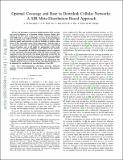Optimal Coverage and Rate in Downlink Cellular Networks: A SIR Meta-Distribution Based Approach
Author(s)
Win, Moe Z.
DownloadSubmitted version (509.8Kb)
Terms of use
Metadata
Show full item recordAbstract
In this paper, we present a detailed analysis of the coverage and spectral efficiency of a downlink cellular network. Rather than relying on the first order statistics of received signal-to-interference-ratio (SIR) such as coverage probability, we focus on characterizing its meta-distribution. Our analysis is based on the alpha-beta-gamma (ABG) path-loss model which provides us with the flexibility to analyze urban macro (UMa) and urban micro (UMi) deployments. With the help of an analytical framework, we demonstrate that selection of underlying degrees-of-freedom such as BS height for optimization of first order statistics such as coverage probability is not optimal in the network-wide sense. Consequently, the SIR meta-distribution must be employed to select appropriate operational points which will ensure consistent user experiences across the network. Our design framework reveals that the traditional results which advocate lowering of BS heights or even optimal selection of BS height do not yield consistent service experience across users. By employing the developed framework we also demonstrate how available spectral resources in terms of time slots/channel partitions can be optimized by considering the meta-distribution of the SIR.
Date issued
2018-12Department
Massachusetts Institute of Technology. Laboratory for Information and Decision SystemsJournal
2018 IEEE Global Communications Conference (GLOBECOM)
Publisher
Institute of Electrical and Electronics Engineers (IEEE)
Citation
Hayajneh, A. M. “Optimal Coverage and Rate in Downlink Cellular Networks: A SIR Meta-Distribution Based Approach.” Paper presented at the 2018 IEEE Global Communications Conference (GLOBECOM) (Abu Dhabi, United Arab, 9-13 Dec. 2018): INSPEC Accession Number: 18476076.
Version: Original manuscript